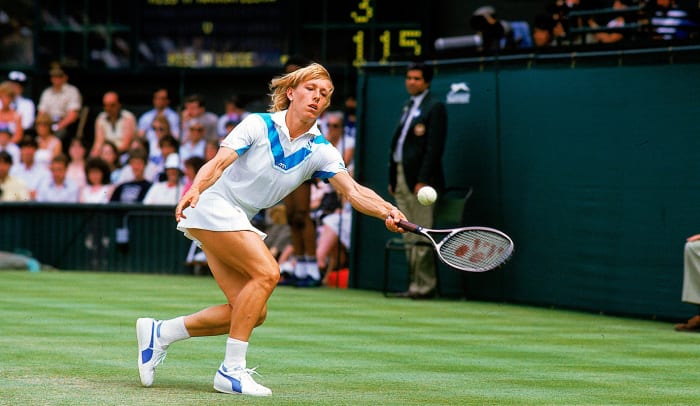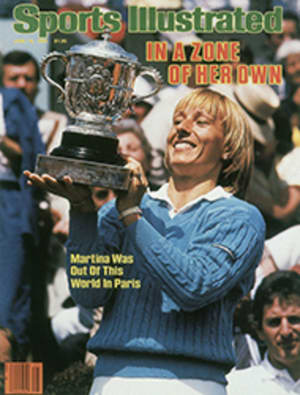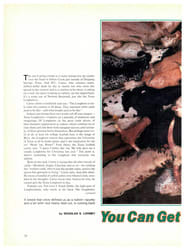Worthy of Really High Fives
Whether the Slam was Grand or Bland or a commercial sham tainted with an asterisk the size of a tennis ball, Martina Navratilova finally did it. Her overwhelming domination of the Championnats Internationaux de France in Paris last week means that, at age 27, she has won the sport's four major tournaments—Wimbledon, the U.S. Open and the Australian Open in 1983, the French in '84—in succession. Moreover, she won them in doubles (with Pam Shriver) as well. Nobody has ever done that before, not Tilden, not Lenglen, not Jesse Jackson. Nobody. Yet the grandeur of the occasion at Stade Roland Garros seemed muted by the sheer redundancy of Navratilova's brilliance.
Like only a very few athletes before her at the peak of their powers—Bobby Jones, Babe Ruth, Edwin Moses—Navratilova is simply too good for her sport. As she herself put it, not unbecomingly, "I have transcended another level." And nobody is following. Chris Evert Lloyd is royalty in retreat. In the singles final on Saturday, Navratilova routed her 6-3, 6-1 to extend her winning streak against Evert Lloyd to 11 matches. Hana Mandlikova and Kathy Horvath, the only ones to beat Navratilova in the past 12 months, are comparative children who happened to have one charmed day. She avenged both of those losses in Paris.
However, diverting attention from Navratilova's accomplishment was the argument over whether she had achieved a genuine Grand Slam. In 1982 the International Tennis Federation, the closest thing the game has to a governing body, decreed that to win the Slam a player simply has to take four majors in a row rather than in a single calendar year, as the previous winners Don Budge (1938), Maureen Connolly ('53), Rod Laver ('62 and '69) and Margaret Smith Court ('70) had done. The ITF also offered a $1 million bonus to anyone who pulled off the feat. On the one hand, Navratilova's four straight majors are hardly less impressive because she didn't win them in the traditional time span. Her victories have come on three surfaces; the other Slammers contended only with grass and clay. On the other hand, Budge's victory in the French in '38, Connolly's in the French in '53 and Court's at Wimbledon in '70 gave all of them four consecutive majors over two years, but no claim of Slam was made until they had won the year's remaining majors. In any case, there won't be many wagers against Navratilova's obliterating the controversy by sweeping the Slam titles this year, which would give her seven in a row.
Fact is, the presumption of Navratilova's magnificence outweighs appreciation of it and tends to inspire apathy. But on the other side of the aisle, the men's side, someone or other regularly comes up with a performance as inspirational as it is wholly unexpected. Ivan Lendl, for instance. You recall Lendl. Ivan the Terrible, Ivan the Terrible Choker, who had gagged his way to defeat in four Grand Slam finals and had recently acquired the habit of losing to John McEnroe. Mac had won their last five matches and 12 of their last 13 sets. On Sunday in the men's final, Lendl was again being ground into the red-brick dust by the all-court artistry of his tormentor.
Over two weeks in a Paris virtually weeping with rain, McEnroe had found a form most mortals only dream of as he stretched his winning streak to 42 matches while combating all his squawking inner demons, not to mention the usual suspects outside: wind, dust, the prevailing showers, umpires, ball kids, spectators, journalists, Arab groundskeepers and the horrid, leering paparazzi. When the sun finally burst through on the weekend, McEnroe's genius seemed to shine all the more brightly. He raced through Lendl in the first two sets, granting only 10 points against serve.
However, McEnroe made a couple of fatal errors. French crowds normally aren't partial to either of these sour-faced fellows, but they regard a three-set laugher with more derision than they do ice cubes in wine. Earnestly desirous of a chance to get into the match themselves, they were accommodated by McEnroe at 1-1 in the third set, when he engaged in another of his stupid harangues—with, what, a television cameraman's headset? Right. After he picked up the offending instrument, which was loudly emitting a director's instructions, graciously yelled "Shut up!" into the attached mike and then cast the headset aside, most of the 18,000 spectators started hooting. Then they got mad. If that wasn't enough, McEnroe got Lendl mad. Two games later, with the whistles of the crowd ringing in his ears, McEnroe blew triple-break point plus another ad. Lendl recovered to break serve himself in the ensuing game and then ran out the set.
Shortly, McEnroe's vicious first serve deserted him—Mac converted only 24 of 70 initial deliveries in Sets 3 and 4. He was feeling weary and, as usual, cross. When Lendl airmailed a few returns past Mac early in the fourth set, McEnroe screamed blasphemies at him, whereupon Lendl stalked to the tape "to make sure he didn't continue." Now McEnroe was confronted with an angry, fist-shaking Lendl, a Lendl of old, the tall, confident bearer of the slingshot forehand who had once beaten him in seven consecutive matches. And a new, bouncing Lendl as well, one who had roared through the tournament losing but a single set and had thrashed Mats Wilander in the semifinals. "John's serve lost speed," said Lendl. "He wasn't as sharp on the attack. He was giving me much more room for the passes."
Despite his struggling, McEnroe twice held service breaks in Set 4, but he wasn't bounding to net anymore, and Lendl kept reloading and moving him around, especially with subtle lobs. Then, in Game 12, after McEnroe was tentative on a couple of volleys, the man in the backgammon shirt broke for the tying set with another terrific lob. McEnroe spoke later of "a snowball effect. I had gotten to such a high level early, when I went down I couldn't come back. Then the crowd got in it. It's frustrating."
The astonishment of the fifth set was that the two players had altered personalities so drastically, Lendl blasting out with self-assured zest, Mac foundering for a strategy to curb the onslaught. Lendl's depth and pace were such that McEnroe couldn't attempt his pet drop shots or get close enough for consistent volleys. And Lendl was positively carving up the court with his own serve. He served four love games in the last set. Finally, with Mac serving at 5-6, the slingshot went down the line for 0-30. A forehand crosscourt passed McEnroe for 15-40. McEnroe bravely saved one match point, but on the second he struck a shoulder-high volley wide. How could he have been so brilliant and then so careless? Had Lendl really come from that far behind to win 3-6, 2-6, 6-4, 7-5, 7-5? Since the 1877 Wimbledon, the first Grand Slam event, only 14 men have overcome a two-set deficit in the final of a major championship.
"It feels great to finally answer some different questions," said Lendl, whose long-overdue first major title could be as important a career-changing event as, say, McEnroe suffering an attack of acute civility. After he again failed to conquer Roland Garros—as American men have failed for 29 years now—Mac brusquely skipped out on the traditional remarks to the crowd and drew blood from the hand of an NBC-TV cameraman as he scraped him with his racket. Luckily, the guy didn't have on his headset.
While Lendl had seemed to be in hiding most of the spring—his only previous victory was in Luxembourg—he had arrived in Paris with a stronger serve, more patience and in much better shape. McEnroe, of course, had been sur un rouleau. By contrast, one wondered where all the French champions of the past decade had gone. Yannick Noah and Wilander hadn't won a tournament all year. Guillermo Vilas, still encumbered by his scarlet letter G (for guarantee), was eliminated in the first round by Heinz Gunthardt after receiving a warning for being "coached" by Ion Tiriac, encumbered by his scarlet letter C (for coach). Adriano Panatta had disappeared from the hot dog line cradling five of the delectable chiens as he waddled away, and Bjorn Borg had just disappeared. Still, the legacy of the six-time champion was felt all over Roland Garros. Four Swedes made the round of 16.
Noah, the defending champion, newly shorn of both bachelorhood and his Rastafarian locks, did emerge to take a two-sets-to-one lead over Wilander in the quarterfinals. But Wilander started exhausting an already exhausted Noah and finding the range with his passing shots. Moreover, Noah was carrying all of France, or at least the part that hadn't journeyed to the D-Day events at Normandy, on his shoulders. At the end he was a withered, beaten former champ, falling 7-6, 2-6, 3-6, 6-3, 6-3.
In the perpetual drizzle, meanwhile, McEnroe's chances depended on his ability to withstand the evil photographers, who, he said, had "pea-sized brains" and were "deliberately trying to annoy me." In his third-round victory over Mel Purcell on Court 1, Roland Garros's second show court, McEnroe became so enraged with the surface craters and the resultant bad bounces that he demanded the groundskeepers repair the place. This was the same match in which McEnroe loudly referred to some cameramen shooting from the dugout pits at the rear of the court as "the most disgraceful exhibition of humanity" and "low levels of life." (Obviously, Junior is inspired to alliteration by Paree; viz. his lyrical "f——French frog fag" number last year.) He also invited a husky shutter snapper to meet him afterward: "You smiling jerk, I dare you." Luckily for McEnroe, the heavyweight declined.
When Amar Segueni and his brothers, Hadj and Mabrouck—for those were the groundsmen's names—arrived on the scene to almost farcically tap dance and kick and stomp the dirt, McEnroe continued to seethe. "Isn't that what people pay for—to see Mac complain?" said Purcell.
"These...workers think they are doing us a favor by being here," McEnroe wailed later. "They do absolutely nothing. It's an absolute disgrace."
Nobody relayed Mac's criticism to the Seguenis for fear they would radio in some Saudi Phantom jets to strafe Center Court, where in his next match, against Jose Higueras, McEnroe drilled two balls into the photographers' pit. After tournament officials threatened to ban cameras from the rearcourt pits, the photographers threatened to strike the tournament. The vision of lensmen and their massive equipment lying all over Roland Garros's hallowed clay and closing down the matches at the French Open forced an immediate truce: The photogs could stay, but there would be no using those noisy motor drives while Mac served.
McEnroe didn't cause any more trouble, unless one counts shouts to the crowd of "Kiss my derriere" or incessant whining about calls. "It's ridiculous," said Jimmy Arias after losing in straight sets to McEnroe in the quarterfinals. "The balls are seven inches out and he's yelling, 'On the line!' John says he only argues when he's positive. Maybe he's got bad eyesight."
Jimmy Connors took matters into his own hands when, behind a set and 2-0 to McEnroe in their hotly anticipated semifinal—LES DEUX CANNIBALES AMERICAINS trumpeted L'Équipe—he approached the net yelling and pointing at Mac. McEnroe had questioned still another call, and Connors had circled a mark that was out. McEnroe kept complaining. So Connors erased the mark. "Shut up. Grow up. You're a baby. I've got a son your age," Connors bellowed, among other things.
"If it's so clearly out, why'd you erase the mark?" McEnroe screamed back. "Don't ever erase the mark again."
Alas, neither erased each other with his fists, and McEnroe won 7-5, 6-1, 6-2. At the end of the runaway, Mac had 12 aces and a handful of lunging volley winners. More significant, he out-dueled Connors from the baseline. Has McEnroe improved on clay in the five years since they last trod the dirt? "Plays the same," said a tight-lipped Connors. "Plays the same on all surfaces."
So, Mr. Haydn, has Mr. Mozart learned any more piano pieces?
Plays the same.
On the distaff side, Evert Lloyd was more charitable, but she refused to accept the notion that Paris was some sort of last stand for her. "I don't know why people are down on me," she said before the final. "Give Martina credit. She's raised her game two levels and I haven't. I know what people are saying, but I don't buy it. I still think I can beat her. And I'm nor quitting. I'm not like Borg—cutting all the ties when I can't win the big one. I love the game too much."
But right there at the edge of the Bois de Boulogne, on her surface, at what she once referred to as her tournament, Evert Lloyd's slip was showing. A week before she had lost the Italian Open, which she used to win in her sleep, to the Bulgarian comer, 17-year-old Manuela Maleeva. At Roland Garros, Evert Lloyd gave up a set, not only to Maleeva but also to Carling (A-Ding) Bassett—"I just love Paris, so much to do. I eat at Pizza Pino every night"—and a stumpy, stocky Soviet teenager named Larissa Savchenko. The one time Evert Lloyd looked like her old self was in a 6-0, 6-0 rout of 17-year-old Camille Benjamin, a surprise semifinalist who surely has the most bizarre strokes in women's tennis.
Meanwhile, Navratilova was all aglow. Once again she has rearranged her life and her entourage, seeming to revel in the strong coaching of former tour player Mike Estep and the emotional support of a new friend from Fort Worth, Judy Nelson, who along with Barbara Estep has taken on some of the duties of Navratilova's former aide-de-gofer, basket-bailer Nancy Lieberman. Also on hand in Paris were old reliables Pam Derderian, Navatilova's former dog walker, who has been promoted to contract negotiator, and Ana Zanova, the cook from Prague who fuels Navratilova with dumplings. Navratilova's parents, Ozzie and Harriet, were there, too. One night Martina attended a concert given by her friend Elton John. "Grand Slam time, Martina," John called out from the stage. "This one's for you." And he played her favorite, Too Low for Zero.
Truthfully, Navratilova is too far above for anybody to catch her in the foreseeable future. Witness her second-set performance against Evert Lloyd. In perhaps the finest single set of her life, Navratilova demonstrated a scintillating array of weapons—monster first serves, crackling volleys, impossible passes and gets from both corners, plus a couple of winning drop shots from the baseline that had Evert Lloyd shaking her head in awe. "Such touch," Evert Lloyd said. "Martina came up with angles I've never seen her play before." For the match Navratilova won 23 of the 34 points on which she took the net, but that didn't even seem necessary. In effect, Navratilova beat Evert Lloyd at her own game, from the baseline. Over one stretch she won 25 of 28 points to go up 5-0, 40-15, double match point. The measure of Evert Lloyd, herself such a great champion, was that she refused to die like that. She ripped off three winners to break serve before succumbing in the next game.
As Navratilova held the silver championship chalice aloft, she looked at it quizzically, as if checking for tarnish. Whether she has won the Grand Slam or just a Grand Slam* may be arguable, but her dominance is beyond dispute.
PHOTO
STEVE
POWELL
After shaking off a Mac attack that put him two sets down, Lendl shook hands with the umpire.
PHOTO
STEVE
POWELL
As the final wore on, approaching the net became increasingly hazardous for McEnroe.
PHOTO
STEVE
POWELL
In their semifinal meeting Connors ordered Mac to "grow up" and "shut up."
PHOTO
STEVE
POWELL
Without his Rastafarian locks, defending champion Noah fell under the weight of his countrymen's expectations and Wilander's passes.
PHOTO
STEVE
POWELL
The relentless Navratilova sliced up Evert Lloyd.
PHOTO
STEVE
POWELL
The Navratilova entourage included (from left, front row) her parents, Zanova, Derderian and Nelson, the newest member.
PHOTO
STEVE
POWELL
Unorthodox strokes put Benjamin in the semis.
PHOTO
STEVE
POWELL
Evert Lloyd: Paris wasn't my last stand.


